What are Google Featured Snippets?
Google Featured Snippets are small sections of text that appear at the top of the search results page. Google pulls these snippets to directly answer a user’s query. These top spots are highly desired because of the large amount of traffic they drive to websites. Today I’m going to show you how to get Google featured snippets easily by mastering search intent.
Below is an example of a Google Featured Snippet:
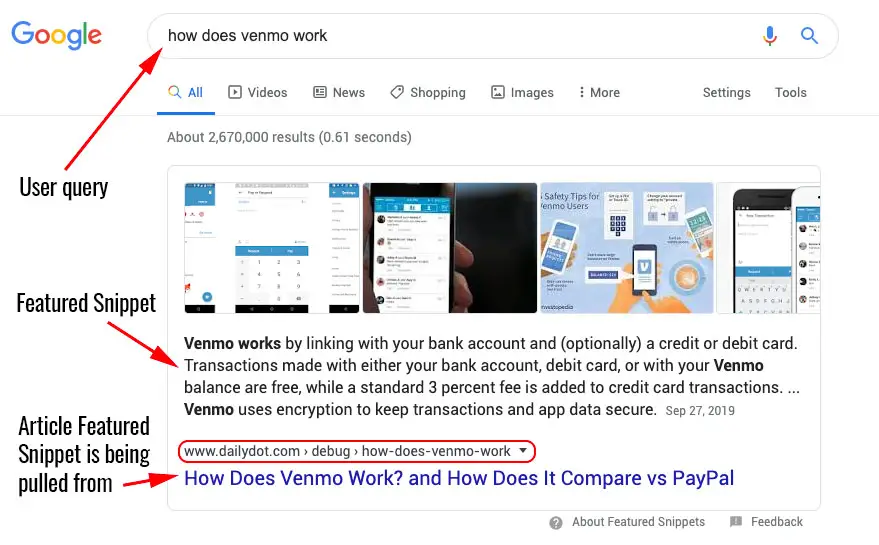
What is search intent?
Search intent is exactly as it sounds—the intent behind a user’s query. Google’s main goal is to have the results page match a user’s search intent. They do this so well that the majority of times the results page always matches the intent of your query.
For example: For the query “SEO tips”, the top six results in the SERP are very similar.
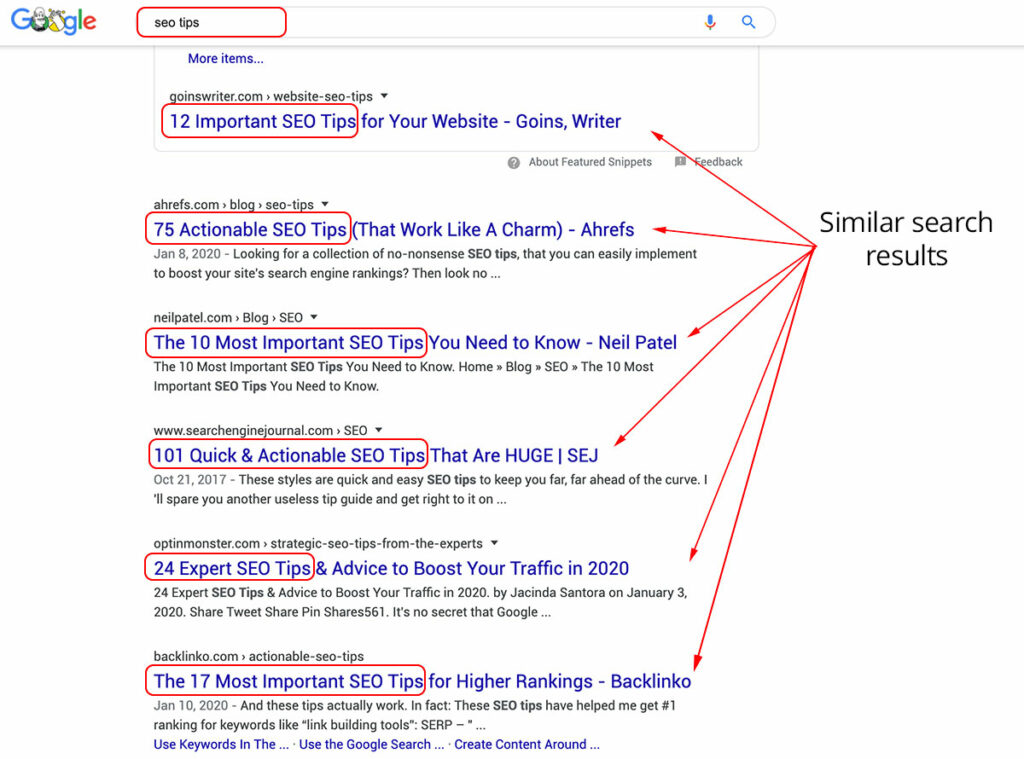
How these search results are similar:
- All six of the top results feature an exact match of the search term “SEO tips”
- The search term “SEO tips” appears within the first 5 words of the article title
- Every article is in the numbered list format: “12 tips, 75 tips, etc.”
These similarities are signs this SERP matches the user’s search intent for the query “SEO Tips.” The best way to understand why these results match search intent is to think of the reasons that make these websites the top results in the first place—they all have a high level of authority on the topic.
Do top Google Search results always have high website authority?
No. But for the more competitive keywords within a topic, websites with high authority are likely the ones on the first page of Google.
Google has never admitted site authority is a ranking factor, but there are many ranking signals that when combined make up a site’s “authority.” SEMRush’s 17 ranking factors are a good go-to reference.
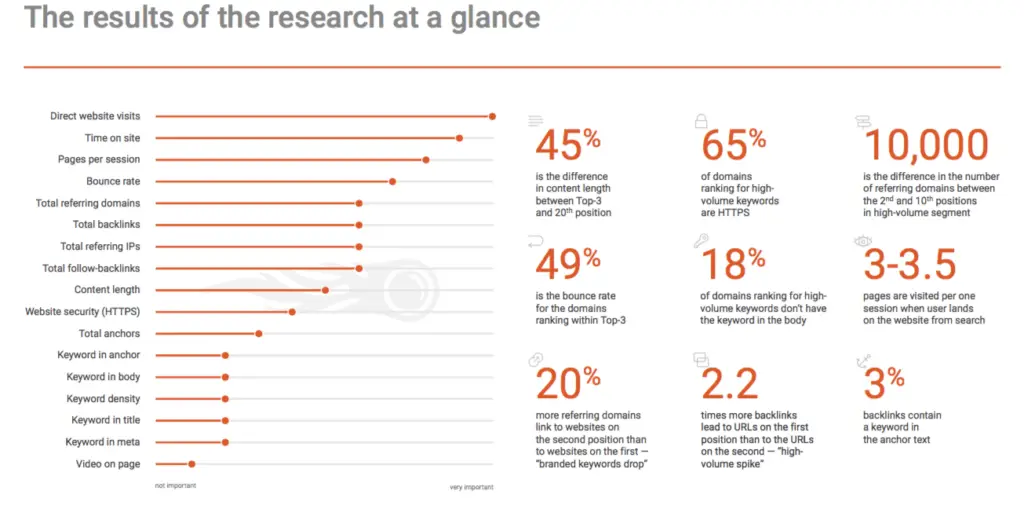
There are other signals Google looks at to determine a site’s authority. Some of these include social media and brand name mentions, the nature of the content itself, and user-generated content on the site (like comments) that show visitors engage with the site.
Googlebot (Google’s crawler) understands your website’s entities, syntax, categories, and sentiments using the Natural Language Cloud. This is how Google understands what your content is about. Additionally, the crawler discovers things like: what is the background of the article’s author? Does this website write about this topic a lot? Googlebot accomplishes this by looking at your internal linking structure, and all the other ranking factors mentioned above.
Some of these signals form the many yearly Google Core Algorithm updates. Websites that write about YMYL (Your Money, Your Life) topics suffered a big hit from the Google Medic Update. We wrote a blog on how to add authority to YMYL sites instantly for websites in those categories.
How can you master search intent when you have a low site authority?
To master search intent when you have a low site authority, you have to go after less competitive SERPS. Imagine your site is in the pet niche. Take a look at this SERP for the query “best dog treats.”
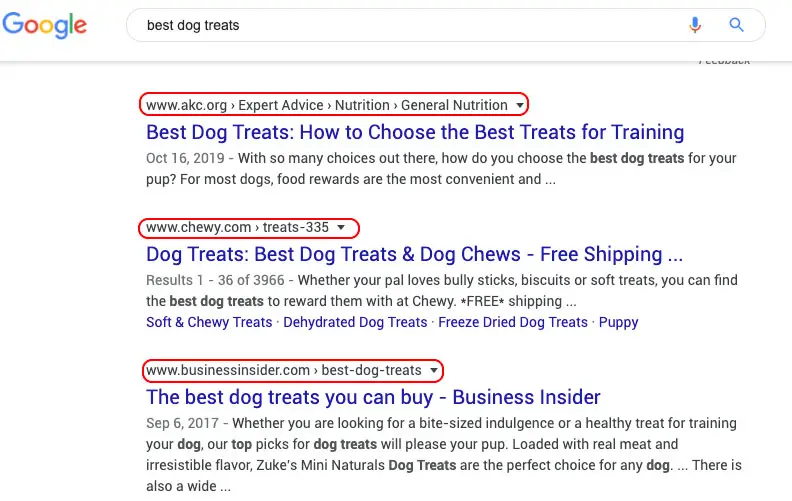
For “Best dog treats,” the top two results were AKC.org and Chewy.com. These two sites are big authorities within the pet space.
If you’re starting out in this niche, chances are it will be nearly impossible to outrank these types of authority sites.
The SERP for the long-tail keyword “best dog treats for cocker spaniels” is less competitive than “best dog treats.” The top four results include a forum and a YouTube video. The other two results are blogs. Additionally, the forum is from 2009. These are all good indicators that this is a good keyword to go after.
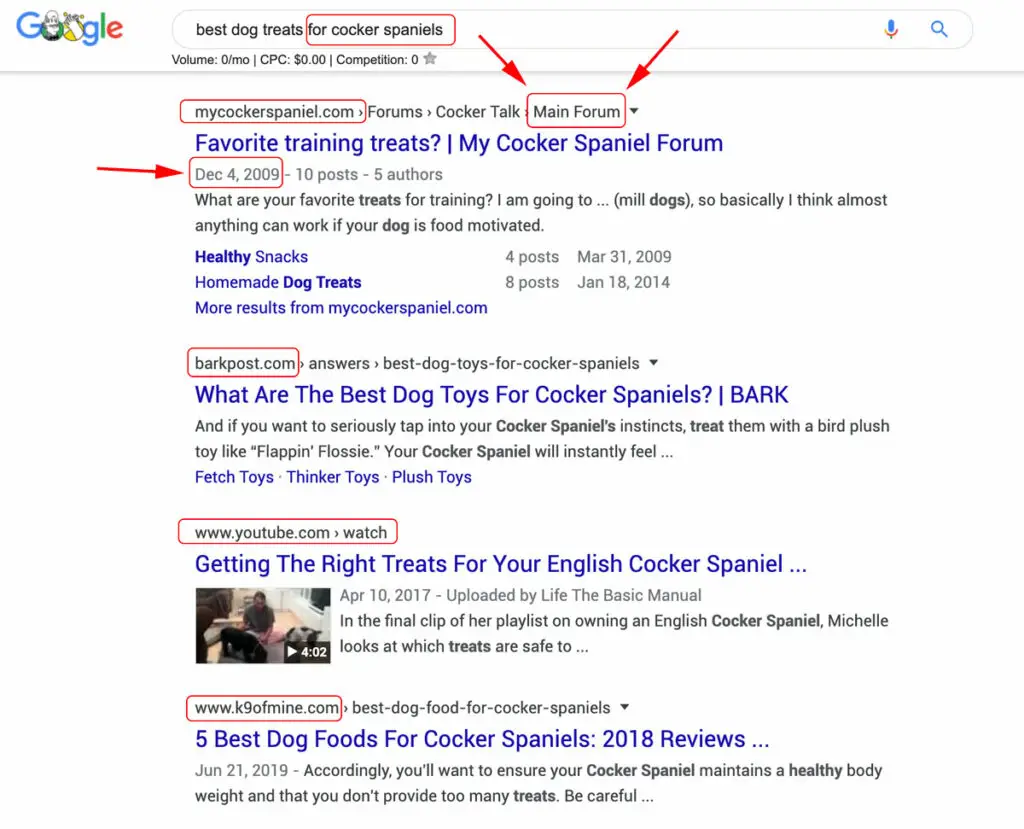
Strong signs of low keyword competitiveness by the results on a SERP are:
- Forums (think Quora or Reddit),
- Posts on social media platforms
- Articles written by other publishers.
- Outdated content
Ahref’s website authority checker allows you to check a website’s authority instantly.

The top result for the query “best dog treats” is AKC.org with a website authority of 90. On the other hand, one of the top results for the long-tail keyword “best dog treats for cocker spaniels” has a website authority of 61. The long-tail keyword is less competitive, therefore it would be easier to outrank the lower-authority site.
Outside of knowing how to do keyword research, there are other tools and strategies that can help you grow when you’re starting out as a publisher:
- A Content Writing Guide To Improve SEO and Visitor Engagement
- Can Small Websites With Low Domain Authority Outrank Large Sites?
- Why You Should Learn SEO Yourself & Avoid Major Pitfalls
Once you’ve mastered the basics of search intent, the next step is to target Google Featured Snippets.
How do you get Google Featured Snippets easily?
The best tactic to get Google Featured Snippets easily is to learn how to make your content directly match the searcher’s intent. If you master the basics of keyword research and writing for SEO, you are well on your way to your first Google Featured Snippet.
There are three steps I take to get Google Featured Snippets easily:
1. Identify the SERP you want your Google Featured Snippet to appear
Once you choose a topic, this should always be your first step. There are two main elements of SERPS I look for that make them good candidates for Google Featured Snippets. The first is to make sure the SERP isn’t cluttered with ads.
For the query “CCPA compliance guide,” there are four ads at the top. The Google Featured Snippet is the fifth result, which is invisible unless you scroll down.

This is a horrible candidate for targeting a featured snippet. If the SERP of the keyword you want to target looks like this, scrap it entirely or find a long-tail alternative.
The second element I look for to identify the SERP I want my Google Featured Snippet to appear in is…that there’s no existing featured snippet on the SERP. While this isn’t always the case, it makes getting a featured snippet a lot easier.
2. Optimize your content for Google Featured Snippets
Once you’ve found the SERP you want to target, you want to want to optimize your content so Google can pull the featured snippet from it.
Here’s a Google Featured Snippet I targeted successfully.
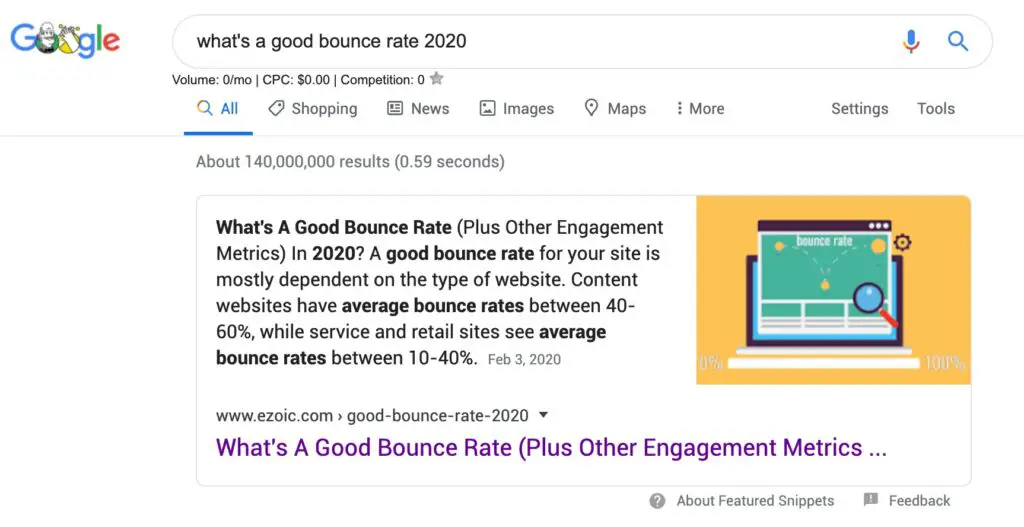
Here is the text that I used to create this Featured Snippet.

Google pulled my focus keyphrase from the beginning of the article. If you use a tool like Yoast SEO, you can set your article’s focus keyphrase easily.
I directly answered the query, “What’s a good bounce rate?” by signaling to Google with my focus keyphrase “A good bounce rate.” The answer came immediately after the focus keyphrase. Additionally, the text length for my featured snippet is 45 words.
Important: Moz analyzed 1.4 million featured snippets and discovered the optimal length for featured snippets to be 40-50 words.
While you don’t have to always hit 40-50 words, the closer you can get to that sweet spot, the better.
Google Featured Snippets can come from any part of your text, not just the introduction.
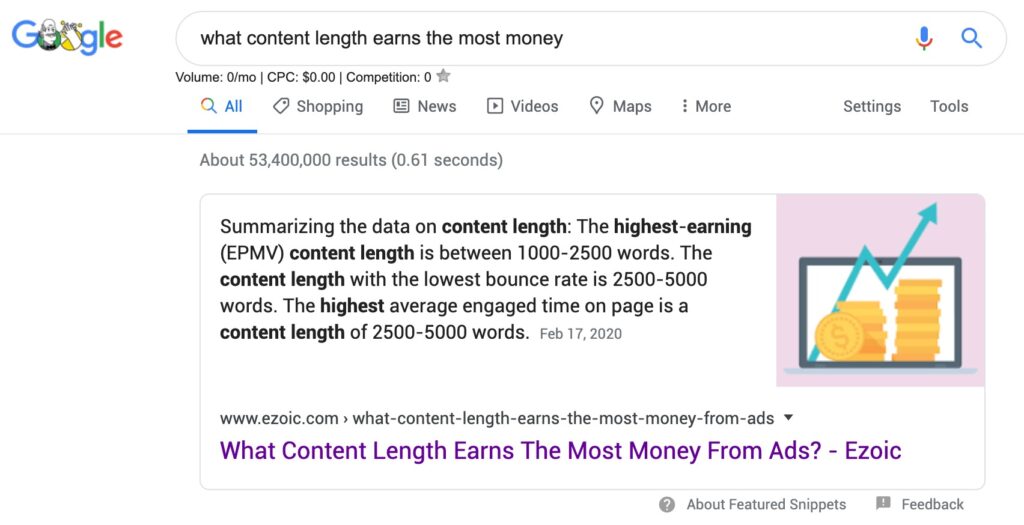
For example, this featured snippet on “what content length earns the most money” came from the conclusion paragraph.
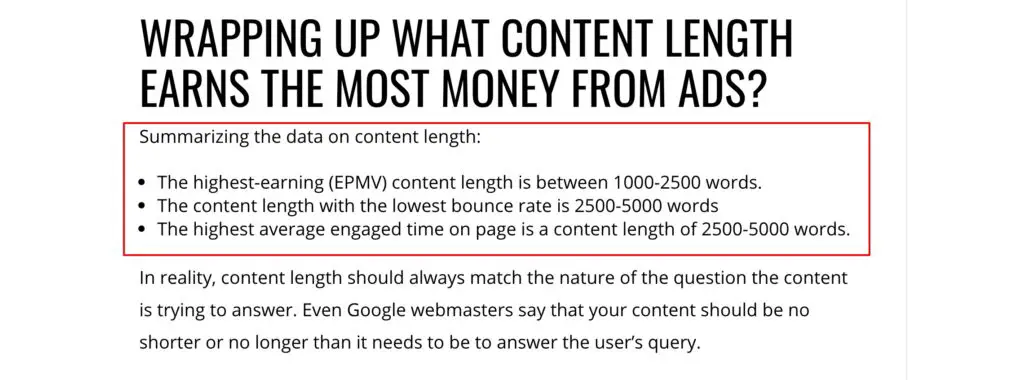
By writing, “Summarizing the data on content length:” I signaled to Google that I was going to recap all of the article’s data.
Featured snippets can also come from any subsection of your article.
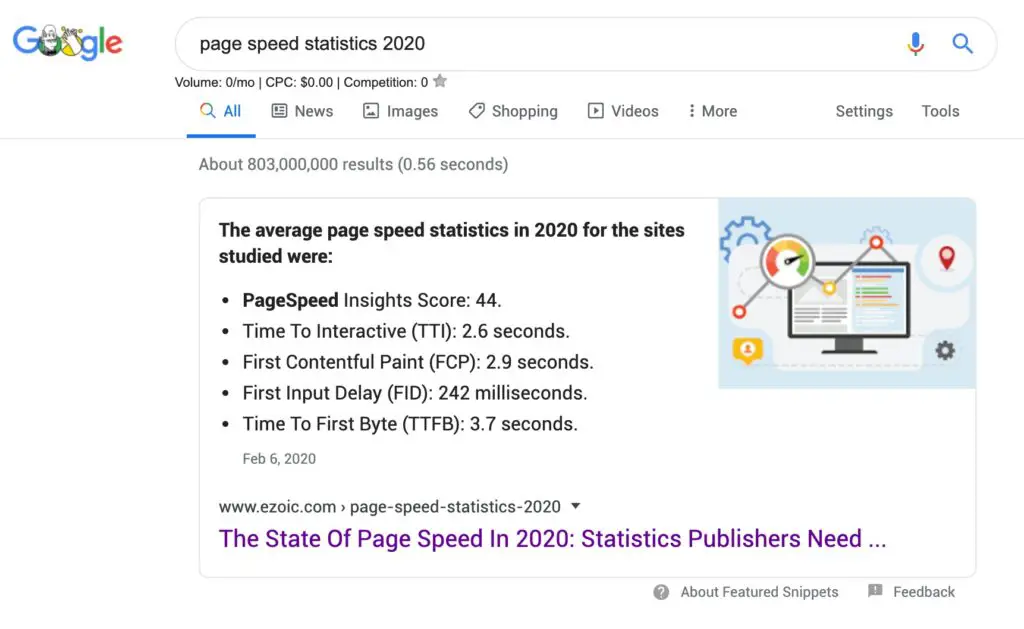
This featured snippet came from one of the H2 sections.
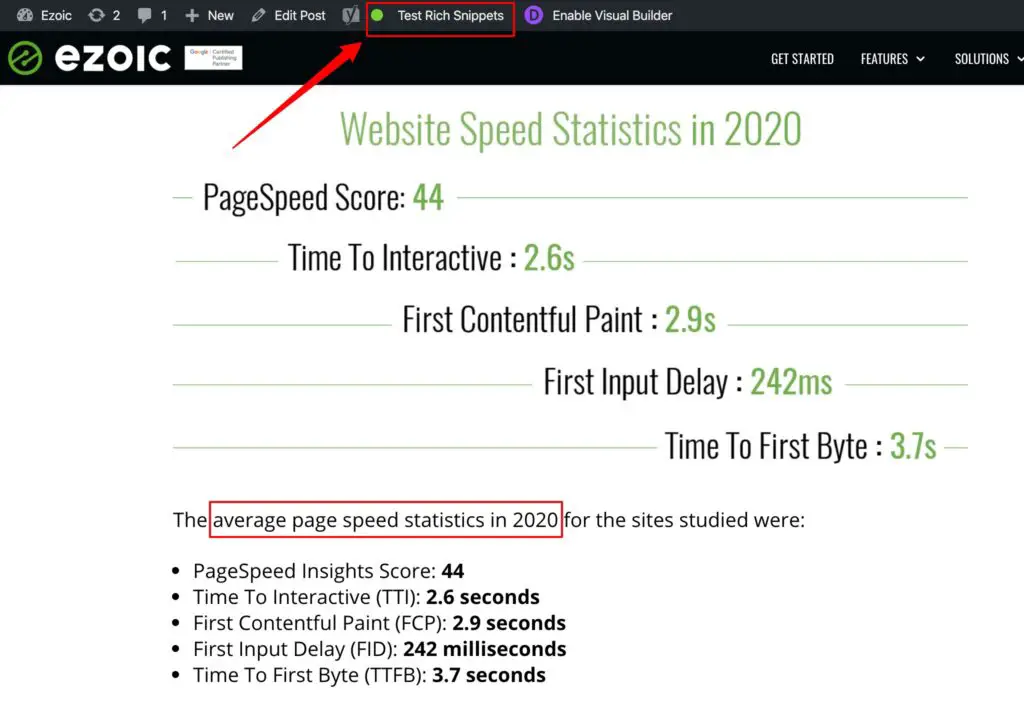
The formula to optimize your content to get Google Featured Snippets easily can be repeated many times.
- Identify desired SERP/Google Search Keyphrase: “Best dog treats for cocker spaniels”
- Match focus keyphrase to signal an answer: “Best dog treats for cocker spaniels…”
- Create a concise 40-50 word answer: “The best dog treats for cocker spaniels according to the AKC are X, Y, and Z…”
These three examples of featured snippets were on SERPS that had no ads or previously-existing featured snippets for the target keyword. Additionally, Google’s Structured Data Testing Tool lets you test your content for featured snippets once you’ve published the content.
3. Look for opportunities where the top Google result doesn’t match search intent
Google is typically so skilled at matching a SERP to a user’s query that it’s rare to find a top result that could be better matched to search intent.
When you identify one of these SERPS, it presents an opportunity to knock out the mismatched result from the top spot by creating content that better matches the search intent. When I searched the keyphrase “Top earning website categories,” the top result didn’t match the search intent.
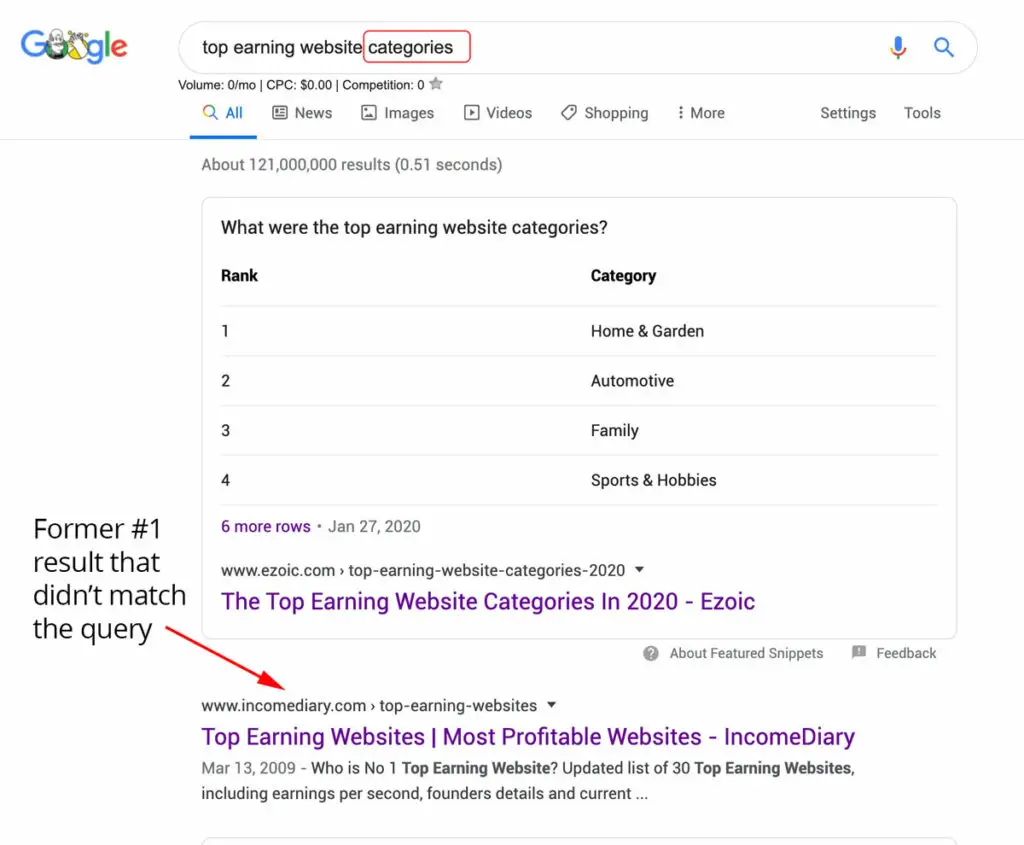
The former number one article focused on “The top earning websites.” Yet that website appeared for the query that included website categories. This meant there was an opportunity to create content that directly matched the query.
Before knocking the income diary out of the top spot, it had a Google Featured Snippet for this query.
To understand how this works, think about search intent from the perspective of a user: If I’m searching for “Top earning website categories,” do I really want a top result that lists off the individual websites that earn the most annual revenue?”
No, because that result doesn’t match the query’s search intent. That result makes more sense for “Top earning websites” but not “Top earning website categories.” Similarly, a niche publisher who wanted to know the most profitable website categories would have found a result that doesn’t answer their question.
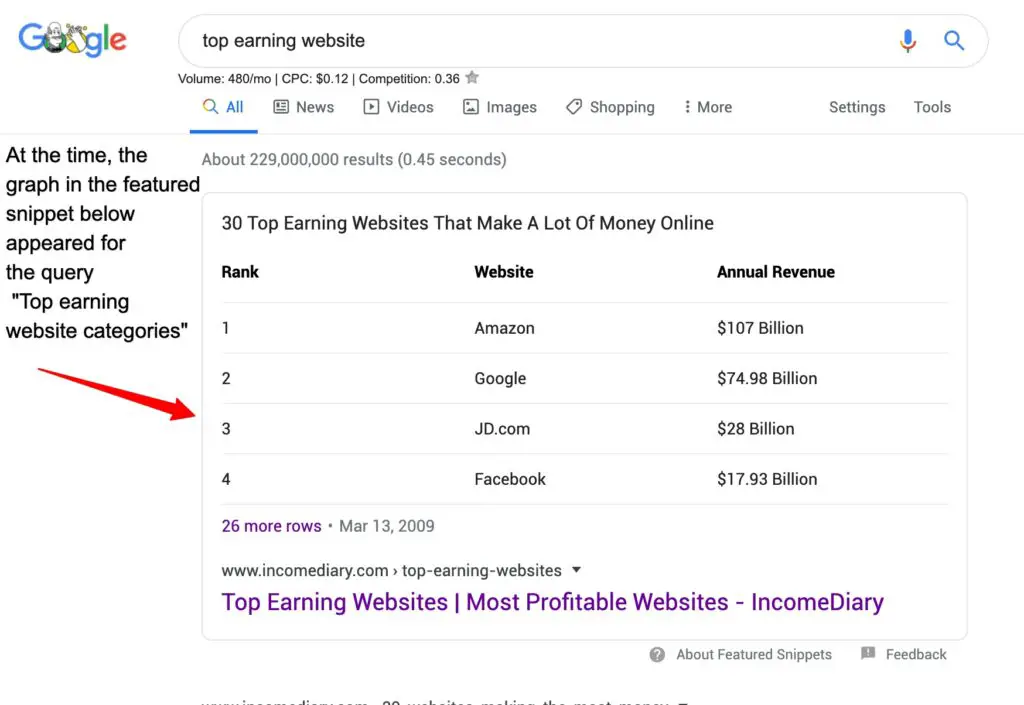
When I wrote the article on the top earning website categories, I made an HTML table that displayed the category data.

I created the data table easily using the Tablepress WordPress plugin. After a few days, my featured snippet replaced the Income Diary’s featured snippet for the query “Top earning website categories.”
Most importantly, always keep a watchful eye for opportunities like this when trying to get Google Featured Snippets.
Why are featured snippets important for increasing site traffic?
Featured snippets are important for increasing site traffic because as long as the SERP isn’t cluttered with ads, your article will be the top result.
Data shows why the top spot on Google Search results is so valuable.
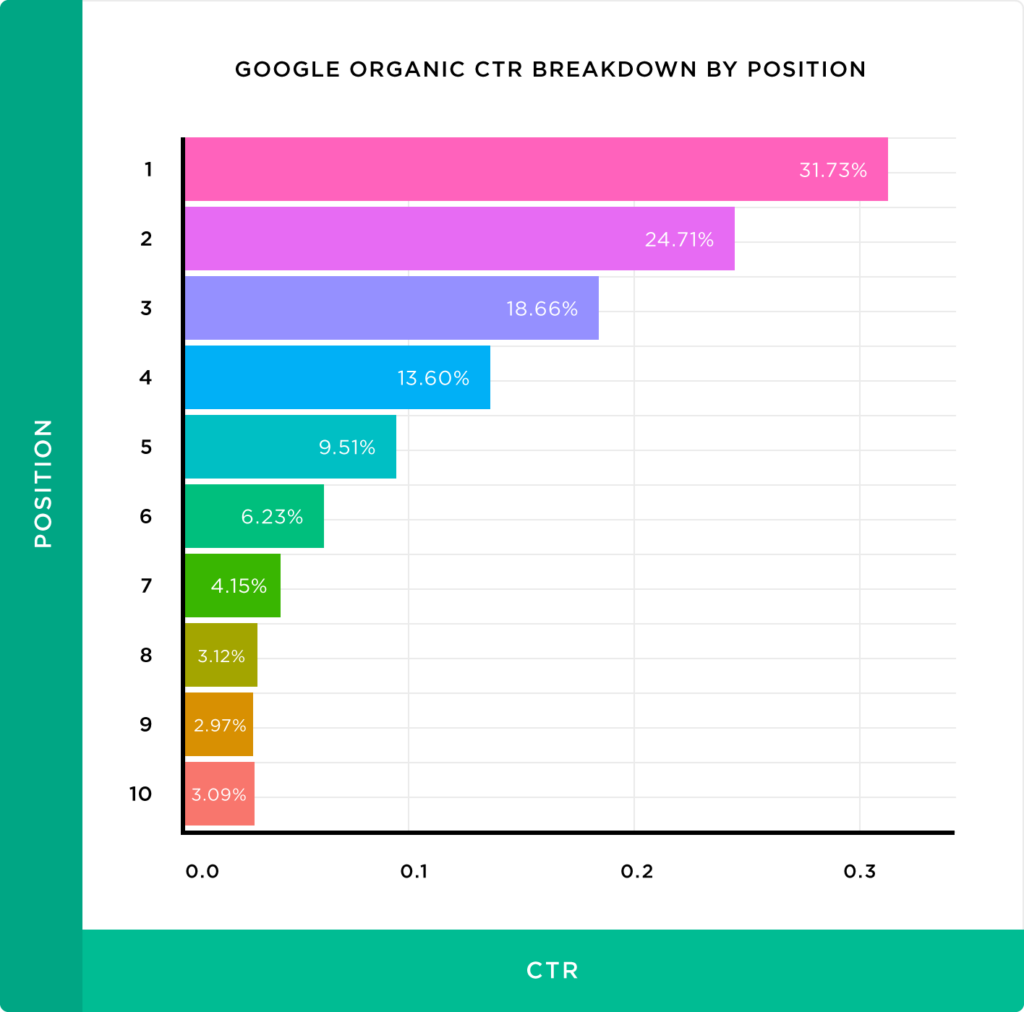
The top result on the first page of Google has a click-through (CTR) rate of 31.73%. On the other hand, the tenth result is drastically lower at CTR of 3.09%.
Gaining just one featured snippet for a higher-volume keyword can boost your site’s traffic significantly. So if you use keyword research tools like SEMRush or Keywords Everywhere, you can identify keywords that have higher search volumes.
For publishers that are just beginning, it may be difficult to rank for higher-volume keywords. Especially if your goal is to rank number one as a featured snippet.
If you target less-competitive keywords with a volume of at least 100 searches per month, those add up over time. Additionally, growing your site’s authority helps improve its ability to rank. We wrote a blog on 5 proven ways websites can get attention, links, and traffic to help publishers accomplish just that.
Are there additional ways to optimize content for featured snippets?
The easiest additional way to optimize content for featured snippets is to refer to the “People Also Ask” section of the Google SERP. For example, let’s say your target keyword is “How many moons does Saturn have?”
If you title your article, “How many moons does Saturn have?” the People Also Ask section of the SERP has drop-down tabs that when opened, continue to produce additional related queries people search. Each drop-down is a featured snippet pulled from different (and sometimes the same) sources.
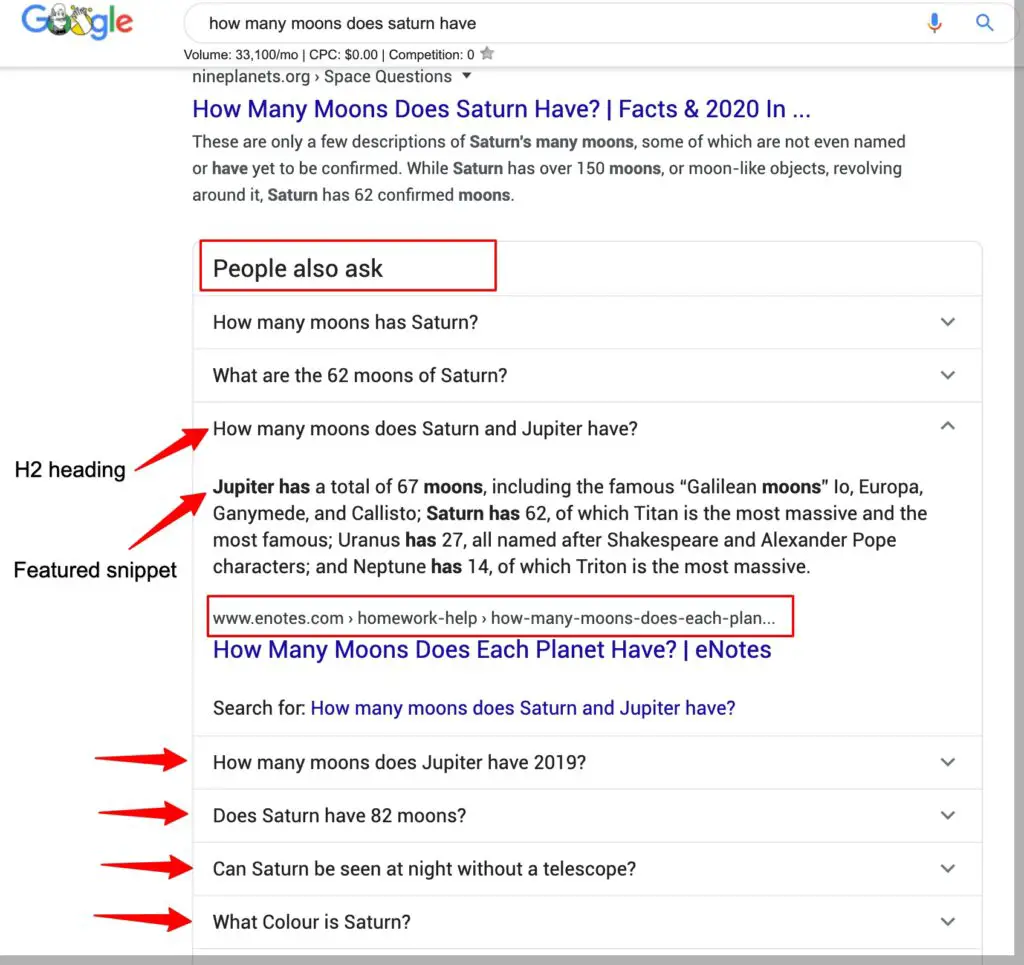
If other articles cover just basic facts about Saturn, in contrast, you could create “The ultimate guide to Saturn.” The People Also Ask section provides nearly limitless questions people search for that can work as H2 or H3 subheadings within the article.
If you use these People Also Ask questions to title your H2 and H3 headings, Google may pull your answers to these questions as featured snippets for each specific drop-down tab.
Wrapping up how to get Google Featured Snippets easily by mastering search intent
Summarizing the steps on how to get Google Featured Snippets easily:
- Identify the SERP you want your Google Featured Snippet to appear
- Optimize your content for Google Featured Snippets
- Match your focus keyphrase to signal a direct answer to the user’s Google query
- Create a concise 40-50 word answer
- Look for opportunities where the top Google result doesn’t match search intent
These steps have proven to be successful in getting Google Featured Snippets time and again. However, the success of these steps is magnified by your website’s authority.
For example: If you run a home & garden website and have 100+ articles published, a decent amount of organic backlinks, social shares, organic traffic, existing keywords ranking, etc.—you have higher domain authority.
Therefore, you’ll be able to use these steps immediately to get Google Featured Snippets easily.
For publishers just starting their websites, these steps may take longer to gain your first Google Featured Snippet. But in time it will work like a charm. Here are some resources to quickly grow your site’s authority:
- Tips From Niche Website Owners On Growing A Site In 2020
- 8 Steps to Building a Site That Makes Over $1,000 a Month
- How To Do A Quantitative Competitor Analysis For Your Website
- Use Social Media Platforms to Increase Website Traffic In 2020
- Tips To Quickly Rank High In SEO So That Google Sends You Traffic
Do you have any questions on how I got these Google Featured Snippets or questions about search intent? Let me know in the comments.


